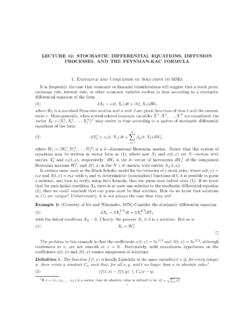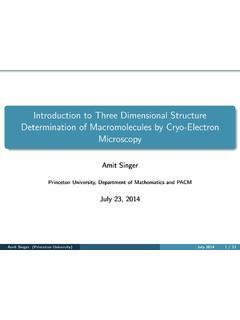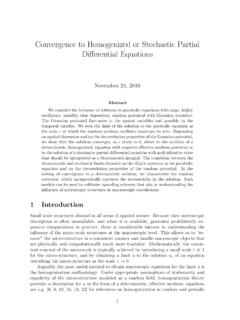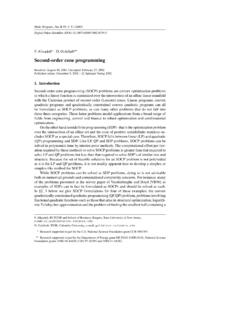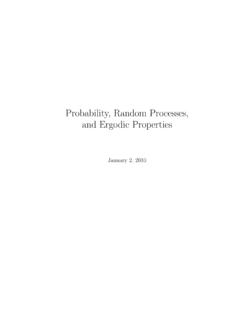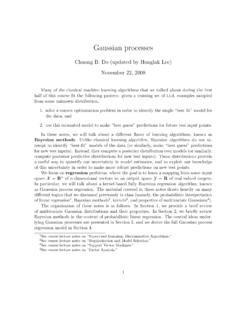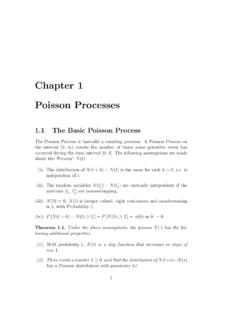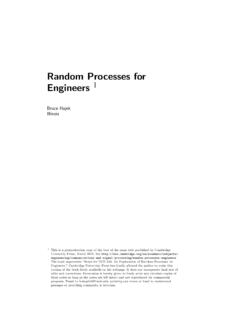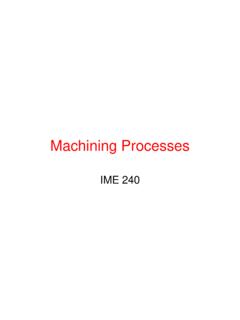Transcription of LECTURE 12: STOCHASTIC DIFFERENTIAL EQUATIONS, …
1 LECTURE12:STOCHASTICDIFFERENTIALEQUATION S,DIFFUSIONPROCESSES,ANDTHEFEYNMAN-KAC is frequentlythecasethateconomicor nancialconsiderationswillsuggestthata stock price,exchangerate,interestrate,or othereconomicvariableevolves in timeaccordingto a stochasticdi erentialequationof theform(1)dXt= (t; Xt)dt+ (t; Xt)dWtwhereWtis a standardBrownianmotionand and aregiven functionsof timetandthecurrentstatex. Moregenerally, whenseveralrelatedeconomicvariablesX1; X2; : : : ; XNareconsidered,thevectorXt= (X1t; X2t; : : : ; XNt)Tmay evolve in timeaccordingto asystemof stochasticdi erentialequationsof theform(2)dXit= i(t; Xt)dt+dXj=1 ij(t; Xt)dWjt;whereWt= (W1t; W2t; : : : ; Wdt) is ad be writtenin vectorformas (1),wherenowXtand (t; x) areN vectorswithentriesXitand i(t; x), respectively;dWtis thed vectorof incrementsdWjtof thecomponentBrownianmotionsWjt; and (t; x) is theN d matrixwithentries ij(t; x).
2 In certaincases,such as theBlack-Scholesmodelforthebehaviorof a stock price,where (t; x) =rtxand (t; x) = txwithrtand tdeterministic(nonrandom)functionsoft, it is possibleto guessa solution,andthento verify, usingIt^o'sformula,thattheguessdoes indeedobey (1).If we knewthatforeach initialconditionX0thereis at mostonesolutionto thestochasticdi erentialequation(1),thenwe couldconcludethatourguessmustbe dowe know thatsolutionsto (1)areunique?Unfortunately, it is notalways thecasethattheyare!Example1:(Courtesyof It^o andWatanabe, 1978)Considerthestochasticdi erentialequation(3)dXt= 3X1=3tdt+ 3X2=3tdWtwiththeinitialconditionX0= 0. Clearly, theprocessXt 0 is a is(4)Xt=W3t: Theproblemin thisexampleis thatthecoe cients (t; x) = 3x1=3and (t; x) = 3x2=3, althoughcontinuousinx, arenotsmoothatx= , mildsmoothnesshypothesesonthecoe cients (t; x) and (t; x) ensureuniquenessof (t; x)islocallyLipschitzin thespace variable(s)xif, foreveryintegern, there existsa constantCnsuchthat,forallx; y, andtno largerthannin absolutevalue1,(5)jf(t; x) f(t; y)j Cnjx yj:1 Ifx= (x1; x2; : : : ; xn) is a vector,thenitsabsolutevalueis de nedto bejxj= ,onerarelyneedstoverifythiscondition,bec ausethefollowingis true,by themeanvaluetheoremof calculus:Iff(t; x)is continuouslydi erentiable,thenit locally thecoe cients in a stochasticdi erentialequationhas\corners"(forinstance ,thefunctionf(x) =jxj).
3 Such functionsarelocallyLipschitzbutnotcontin uouslydi i(t; x)and ij(t; x)are all locally Lipschitzin thespacevariablex. ThenforeachinitialconditionX0=x0, there is at mostonesolutionto thesystemofstochasticdi erentialequations(2).Aretherealwayssolut ionstostochasticdi erentialequationsof theform(1)?No!Infact,existenceof solutionsforalltimet 0 is notguaranteedevenforordinarydi erentialequations(thatis, di erentialequationswithnorandomterms).It is important to understandwhy di erentialequation(ora systemof di erentialequations)prescribes how thestatevectorXtwillevolve in any smalltimeintervaldt, foras longas thestatevectorremains ,thereis noreasonwhy thestatevectormustremain niteforalltimest :Considertheordinarydi erentialequation(6)dxdt=11 tfor0 t <1:Thesolutionfortheinitialconditionx0is (7)x(t) =x0+Zt0(1 s) 1ds=x0 log(1 t)for0 t <1:Astapproaches1,x(t) convergesto1.
4 Example3:Thepreviousexampleshowsthatif thecoe cients in a di erentialequationdependexplicitlyontthens olutionsmay \explode"in occureven if thedi erentialequationisautonomous, thatis, if thecoe cients erentialequationis(8)dxdt=x2:Thegenerals olutionis(9)x(t) = (t C) 1:For theinitialconditionx(0)=x0>0, thevalueofCmustbeC= 1=x0. Consequently, thesolutionx(t) explodesastapproaches1=x0. Observe thatin Example2, thecoe cient (t; x) =x2is notonlytime-independent, butcon-tinuouslydi erentiable, ,thehypothesesof Theorem1 donotguaranteeexistenceof solutionsforallt. Thenexttheoremgives usefulsu cient conditionsfortheexistenceof cientsin thesystem(1)of stochasticdi erentialequationssatisfythefollowingglob alLipschitzandgrowthconditions:forsomeC <1,j i(t; x) i(t; y)j Cjx yjforallt2 Randx; y2RN(10)j ij(t; x) ij(t; y)j Cjx yjforallt2 Randx; y2 RNj i(t; x)j Cjxjforallt2 Randx2RN;andj ij(t.)
5 X)j Cjxjforallt2 Randx2RN:Thenforeachx02 RNthere is a (unique)solutionto thesystem(1)suchthatX0= and2 statedabove wereprovedby It^o in thelinesof theclassicalproofsforexistenceanduniquen essof solutionsof ordinarydi erentialequations,withappropriatemodi ,forinstance,Karatzas& theOrnstein-Uhlenbeck processaregivenin professionalprobability, adi usionprocessis a continuous-timestochasticprocessthatsati s esan autonomous(meaningthatthecoe cients and do notdependexplicitlyon thetimevariablet) stochasticdi erentialequationof theform(1).Such processesarenecessarily(strong)Markov ,perhapsthemostimportant di usionprocessis theOrnstein-Uhlenbeckprocess,knownalsoin processis theprototypicalmean-revertingprocess:alt houghrandom,theprocessexhibitsa pronouncedtendencytowardan equilibriumvalue,justas an oscillatingpendulumor springis always pulledtowardits nancialapplications,theOrnstein-Uhlenbec kprocessis oftenusedto modelquantitiesthattendto uctuateaboutequilibriumvalues,such asinterestratesorvolatilitiesof stock erentialequationfortheOrnstein-Uhlenbeck processis(11)dYt= (Yt )dt+ dWt;where ; 2 Rand >0 that,if = 0 thenthisbecomesanordinarydi erentialequationwithan attractive restpoint at.
6 (Exercise:Findthegeneralsolutionwhen = 0, andverifythatast! 1everysolutioncurve convergesto .) Theterm dWtallowsforthepossibility of random uctuationsabouttherestposition ; however,ifYtbeginsto randomlywanderveryfarfrom thenthe\mean-reversion"term (Yt )dtbecomeslarger,forcingYtback toward .Thecoe cients of thestochasticdi erentialequation(11)satisfythehypotheses of Theorem2,andso foreverypossibleinitialstatey02 Rthereis a uniquesolutionYt. In fact,it is possibletogive anexplicitrepresentationof 'strythesimplestcase,where = 0. To guesssuch a representation,trya combinationof ordinaryandstochastic(It^o) integrals;moregenerally,trya combinationof nonrandomfunctionsandIt^o integrals:Yt=A(t) y0+Zt0B(s)dWs ;2A thoroughdiscussionof such issuesis givenin theXXX-ratedbookMultidimensionalDi usionProcessesbeStroock friendlierintroduction,trySteele' (0)= 1.
7 IfA(t) is di erentiableandB(t) is continuous,thendYt=A0(t) y0+Zt0B(s)dWs dt+A(t)B(t)dWt=A0(t)A(t)Ytdt+A(t)B(t)dWt :Matchingcoe cients with(11)showsthatA0(t)=A(t) = andA(t)B(t) = . SinceA(0)= 1,thisimpliesthatA(t) = expf tgandB(t) = expf tg. Thus,forany initialconditionY0=y0,thesolutionof (11)is givenby(12)Yt= expf tgy0+ expf tgZt0expf sgdWsTheexplicitformula(12)allowsus to reado a largeamount of important informationabouttheOrnstein-Uhlenbeck ,recallthatit is always thecasethattheintegralof anonrandomfunctionf(s) againstdWsis a normal(Gaussian)randomvariable,withmeanz eroandvarianceRf(s)2ds. Thus,foreacht,(13)Yt Normal y0e t; 21 e 2 t2 :Ast!1, themeanandvarianceconverge(rapidly!)to 0 and 2=2 , respectively, andso(14)YtD !Normal 0; 22 :ThisshowsthattheOrnstein-Uhlenbeck processhasastationary(orequilibrium, orsteady-state)distribution,andthatit is fact,formula(12) di erent initialstatesy0andy00, andletYtandY0tbe thesolutions(12)to thestochasticdi erentialequation(11)withtheseinitialcond itions,respectively.
8 Then(15)Yt Y0t= expf tg(y0 y00):Thus,thedi erencebetweenthetwo solutionsYtandY0tdecaysexponentiallyin time,at rate .For thisreason is FormulaDi usionprocesses(speci cally, Brownianmotion)originatedin physicsas mathematicalmodelsof themotionsof individualmoleculesundergoingrandomcolli sionswithothermoleculesin a gasor thesubjectwerelaid3, AlbertEinsteinrealizedthatthemicroscopic randommotionof moleculeswas ultimatelyresponsibleforthemacroscopicph ysicalphenomenonofdi usion, andmadetheconnectionbetweenthevolatility parameter of therandomprocessandthedi usionconstant in thepartialdi erentialequationgoverningdi erentialequationsof di usionandheat ow andthe3around1920,by NorbertWiener,whoprovedthatthereis a probability distribution(measure)Ponthespaceof continuouspathssuch that,if onechoosesa pathBtat randomfromthisdistributionthentheresulti ngstochasticprocessis a Brownianmotion,as de nedin the rstaccuratedeterminationof Avagadro'snumber,andlater,in 1921,to a Nobelprizein Brownianmotionhasbeena recurringthemein mathematicalresearch the1940s,RichardFeynmandiscoveredthatthe Schrodingerequation(thedi erentialequa-tiongoverningthetimeevoluti onof quantumstatesin quantummechanics)couldbe solvedby(a kindof) averagingover paths,anobservationwhich ledhimto a far-reachingreformulationofthequantumthe oryin termsof \pathintegrals".
9 5 Uponlearningof Feynman'sideas,MarkKac(a mathematicianat CornellUniversity, whereFeynmanwas,at thetime,anAssistant Professorof Physics)realizedthata similarrepresentationcouldbe givenforsolutionsof theheatequation(andotherrelateddi usionequations) nowknownas theFeynman-Kacformula. Laterit becameevident thattheexpectationoccurringinthisreprese ntationis of thesametype thatoccursin derivative security coolingtermis(16)@u@t=12@2u@x2 K(x)u;whereK(x) is a functionof thespacevariablexrepresentingtheamount of (Feynman-KacFormula)LetK(x)be a nonnegative,continuousfunction,andletf(x )be bounded (t; x)is a bounded functionthatsatis esthepartialdi erentialequation(16)andtheinitialconditi on(17)u(0; x) =lim(t;y)!(0;x)u(t; y) =f(x):Then(18)u(t; x) =Exexp Zt0K(Ws)ds f(Wt);where, undertheprobabilitymeasurePx, theprocessfWtgt 0is Brownianmotionstarted thetheoremremainsvalid,butsu ceformany important (x) andf(x) thatarenotcontinuouseverywhere,buthave onlyisolateddiscontinuities;theFeynman-K acformularemainsvalidforsuch functions,buttheinitialcondition(17)hold sonlyat theformulais uniquenessof solutionsto theCauchyproblem(thepartialdi erentialequation(16)togetherwiththeiniti alcondition(17).)
10 Theorem3, there is at mostonesolutionof theheat equation(16)withinitialcondition(17),spe ci cally, thefunctionude ned by theexpectation(18). TheFeynman-Kacformulamay alsobe usedas thebasisforanexistencetheorem,butthisisn otso simple,andsinceit is somewhattangentialto ourpurposes,we spelledoutin considerabledetailin thebookQuantumMechanicsandPathIntegralsb y nontechnicalexplanation,readFeynman'slat erbookQED, surelyoneof the nestpopularexpositionsof a scienti ctheoryever of >0, andconsiderthestochasticprocessYs=e R(s)u(t s; Ws);whereR(s) = exp Zs0K(Wr)dr withsnow (t; x) is,by hypothesis,a solutionof theheatequation(16),it is continuouslydi erentiableonceintandtwiceinx. Moreover,sinceuisbounded,so is theprocessYt. ByIt^o'stheorem,dYs= K(Ws)e R(s)u(t s; Ws)ds ut(t s; Ws)e R(s)ds+ux(t s; Ws)e R(s)dWs+ (1=2)uxx(t s; Ws)e R(s)ds:Sinceusatis esthepartialdi erentialequation(16),thedstermsin thelastexpressionsumtozero,leaving(19)dY s=ux(t s; Ws)e R(s)dWs:Thus,Ysis a martingaleupto \Conservationof Expectation"law formartingales,it followsthat(20)Y0=u(t; x) =ExYt=Exe R(t)u(0; Wt) =Exe R(t)f(Wt):Aswe have remarked,thehypothesesof Theorem3 may be relaxedconsiderably, butthisisa culty hasto dowithconvergenceissues:whenfis anunboundedfunctiontheexpectationin theFeynman-Kacformula(18)neednotevenbewe ll-de solutionsto theCauchy problemis ,forinstance,thesimplecasewheref 0 andK 0; thenthefunction(21)v(t; x) =1Xn=0x2n(2n)!

